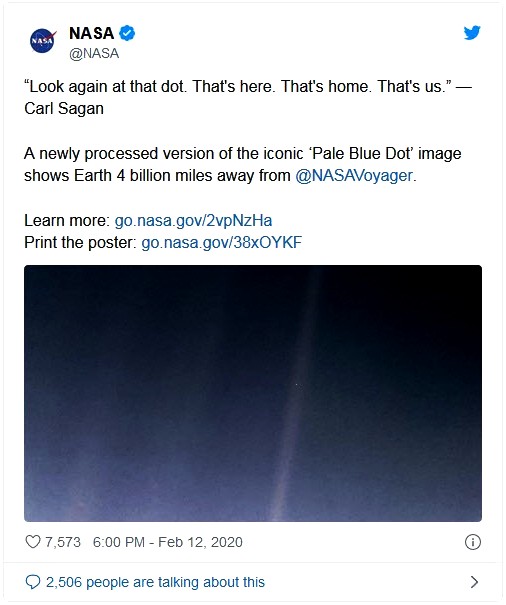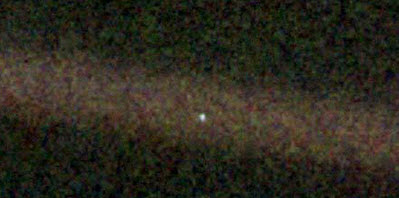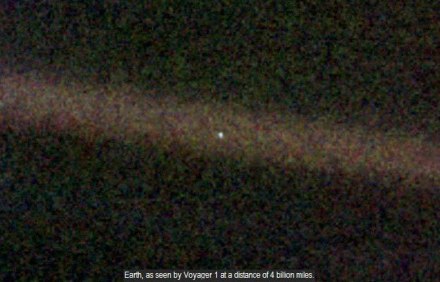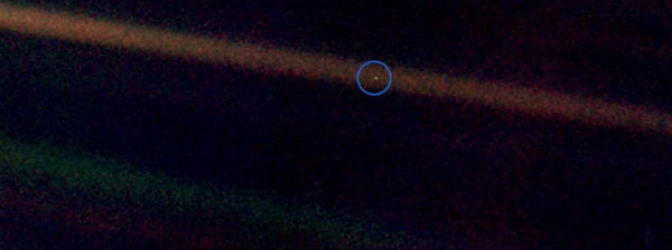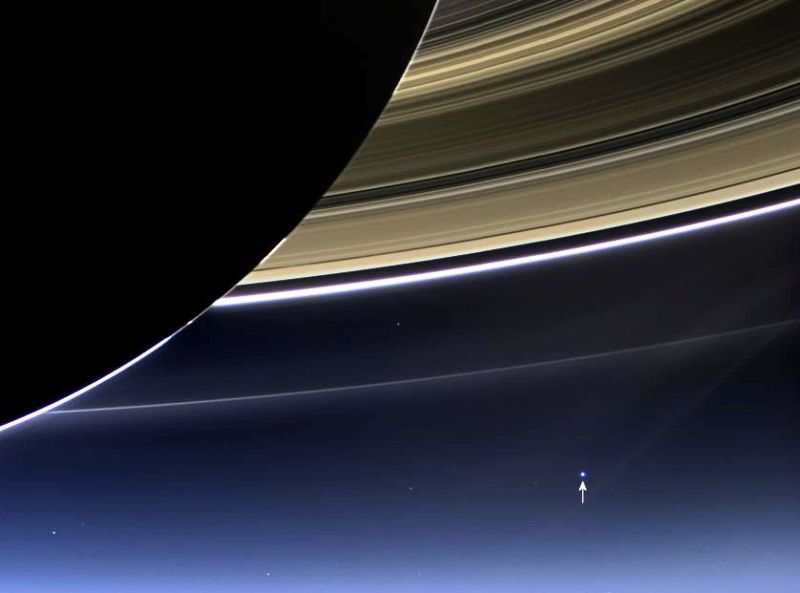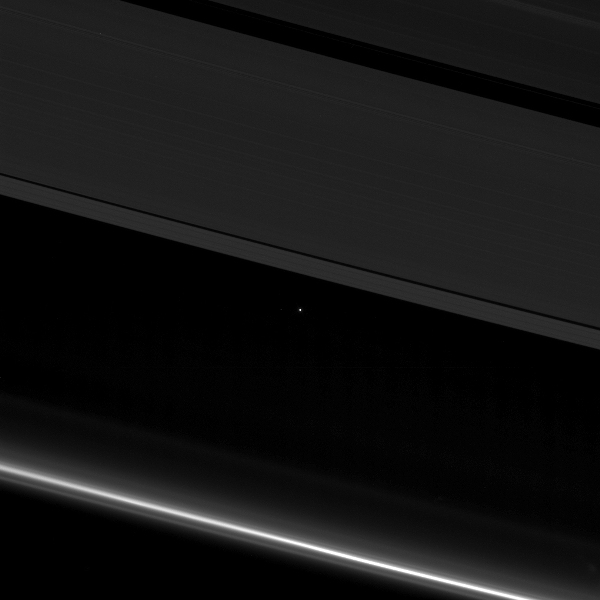Pale blue dot: Difference between revisions
Siterunner (talk | contribs) No edit summary |
Siterunner (talk | contribs) No edit summary |
||
| (29 intermediate revisions by the same user not shown) | |||
| Line 1: | Line 1: | ||
''Pale Blue Dot is a photograph of planet Earth taken on February 14, 1990,'' | |||
[[File:Pale Blue Dot | : ''by the Voyager 1 space probe from a record distance of about 6 billion kilometers,'' | ||
:: ''the photos were part of that day's 'Family Portrait' series (-- via Wikipedia)'' | |||
<big>''Blue Dot Revisited''</big> -- [https://www.nasa.gov/feature/jpl/pale-blue-dot-revisited '''''go.nasa.gov/2vpNzHa'''''] | |||
[[File:Sagan - That's home.jpg]] | |||
:::[[File:Pale Blue Dot.jpg]] | |||
:::[[File:PaleBlueDot.jpg]] | |||
| |||
<big><big>''''' "Suspended in a sunbeam..." '''''</big></big> | |||
: [https://www.greenpolicy360.net/w/File:Pale-blue-dot.jpg ''"This point of pale light... a lonely speck... distant image of our tiny world"''] | |||
::* https://solarsystem.nasa.gov/resources/536/voyager-1s-pale-blue-dot/ | |||
[[File:PaleBlueDot-.jpg|link=File:Pale-blue-dot.jpg]] | |||
'''''February 2020''''' | |||
<big><big>''Iconic ‘pale blue dot’ photo – Carl Sagan’s idea – turns 30''</big></big> | |||
* https://news.cornell.edu/stories/2020/02/iconic-pale-blue-dot-photo-carl-sagans-idea-turns-30 | |||
''For the 30th anniversary of one of the most iconic views from the Voyager mission,'' | |||
''NASA's Jet Propulsion Laboratory in Pasadena, California, has published a new version of the image known as the "Pale Blue Dot."'' | |||
[https://www.nasa.gov/feature/jpl/pale-blue-dot-revisited ''The updated image] uses modern image-processing software and techniques...'' | |||
''Like the original, the new color view shows Planet Earth as a single, bright blue pixel in the vastness of space.'' | |||
''Rays of sunlight scattered within the camera optics stretch across the scene, one of which happens to have intersected dramatically with Earth.'' | |||
GreenPolicy360: Oh [http://www.planetcitizen.org '''Planet Citizens'''] | |||
...''''' "preserve and cherish the pale blue dot, the only home we've got" ''''' | |||
○ | |||
| Line 29: | Line 89: | ||
[[File: | [[File:Pale Blue Dot - The Book by Carl Sagan 2.jpg]] | ||
○ | |||
[https://saturn.jpl.nasa.gov/news/3028/nasa-image-shows-earth-between-the-rings-of-saturn/ '''''Earth between the rings of Saturn...'''''] | |||
<small>'''''Image taken July 19, 2013 with a wide-angle camera on NASA's Cassini spacecraft capturing Saturn's rings and our planet Earth and Moon'''''</small> | |||
[[File:Pale Blue Dot from Cassini July 19,2013.jpg|link=http://www.jpl.nasa.gov/spaceimages/details.php?id=PIA17171]] | |||
:::[[File:Earth from Cassini-7656 MAIN PIA21445 figA.jpg]] | |||
''In 2006, Cassini imaged Earth in a stunning mosaic of Saturn called “In Saturn's Shadow – The Pale Blue Dot”.'' | |||
''In this rare image taken on 19 July, the wide-angle camera on the international Cassini spacecraft has captured Saturn’s rings and our planet Earth and Moon in the same frame.'' | |||
''The dark side of Saturn, its bright limb, the main rings, the F ring, and the G and E rings are clearly seen; the limb of Saturn and the F ring are overexposed. The ‘breaks’ in the brightness of Saturn’s limb are due to the shadows of the rings on the globe of Saturn, preventing sunlight from shining through the atmosphere in those regions. The E and G rings have been brightened for better visibility.'' | |||
''. | ''Earth, 1.44 billion km away in this image, appears as a blue dot at centre right; the Moon can be seen as a fainter protrusion off its right side. The other bright dots nearby are stars.'' | ||
''This is only the third time ever that Earth has been imaged from the outer Solar System. The first image was taken by NASA’s Voyager-1 in 1990 and famously titled '''“Pale Blue Dot”.''''' | |||
-- European Space Agency / ESA | |||
| Line 59: | Line 125: | ||
[[Category:About Us]] | |||
[[Category:Earth360]] | [[Category:Earth360]] | ||
[[Category:EarthPOV]] | [[Category:EarthPOV]] | ||
[[Category:Earth Imaging]] | |||
[[Category:Earth Observations]] | [[Category:Earth Observations]] | ||
[[Category:ESA]] | |||
[[Category:NASA]] | [[Category:NASA]] | ||
[[Category:Overview Effect]] | [[Category:Overview Effect]] | ||
[[Category:Planet Citizen]] | [[Category:Planet Citizen]] | ||
[[Category:Planet Citizens]] | |||
[[Category:Planet Scientist]] | [[Category:Planet Scientist]] | ||
[[Category:Planetary Science]] | [[Category:Planetary Science]] | ||
[[Category:Space Science and Space Physics]] | [[Category:Space Science and Space Physics]] | ||
[[Category:Whole Earth]] | [[Category:Whole Earth]] | ||
Latest revision as of 16:30, 9 June 2022
Pale Blue Dot is a photograph of planet Earth taken on February 14, 1990,
- by the Voyager 1 space probe from a record distance of about 6 billion kilometers,
- the photos were part of that day's 'Family Portrait' series (-- via Wikipedia)
Blue Dot Revisited -- go.nasa.gov/2vpNzHa
"Suspended in a sunbeam..."
February 2020
Iconic ‘pale blue dot’ photo – Carl Sagan’s idea – turns 30
For the 30th anniversary of one of the most iconic views from the Voyager mission,
NASA's Jet Propulsion Laboratory in Pasadena, California, has published a new version of the image known as the "Pale Blue Dot."
The updated image uses modern image-processing software and techniques...
Like the original, the new color view shows Planet Earth as a single, bright blue pixel in the vastness of space.
Rays of sunlight scattered within the camera optics stretch across the scene, one of which happens to have intersected dramatically with Earth.
GreenPolicy360: Oh Planet Citizens
... "preserve and cherish the pale blue dot, the only home we've got"
○
"Our posturings, our imagined self-importance,
the delusion that we may have some privileged position,
are challenged by this point of pale light.
Our planet is a lonely speck in the great enveloping cosmic dark ....
There is no hint that help will come from elsewhere to save us from ourselves.
This distant image of our tiny world...
underscores our responsibility to deal more kindly with one another,
and to preserve and cherish the pale blue dot, the only home we've got."
--Carl Sagan
Sagan, Pale Blue Dot, 1-7, 331-4
○
Earth between the rings of Saturn...
Image taken July 19, 2013 with a wide-angle camera on NASA's Cassini spacecraft capturing Saturn's rings and our planet Earth and Moon
In 2006, Cassini imaged Earth in a stunning mosaic of Saturn called “In Saturn's Shadow – The Pale Blue Dot”.
In this rare image taken on 19 July, the wide-angle camera on the international Cassini spacecraft has captured Saturn’s rings and our planet Earth and Moon in the same frame.
The dark side of Saturn, its bright limb, the main rings, the F ring, and the G and E rings are clearly seen; the limb of Saturn and the F ring are overexposed. The ‘breaks’ in the brightness of Saturn’s limb are due to the shadows of the rings on the globe of Saturn, preventing sunlight from shining through the atmosphere in those regions. The E and G rings have been brightened for better visibility.
Earth, 1.44 billion km away in this image, appears as a blue dot at centre right; the Moon can be seen as a fainter protrusion off its right side. The other bright dots nearby are stars.
This is only the third time ever that Earth has been imaged from the outer Solar System. The first image was taken by NASA’s Voyager-1 in 1990 and famously titled “Pale Blue Dot”.
-- European Space Agency / ESA
○
